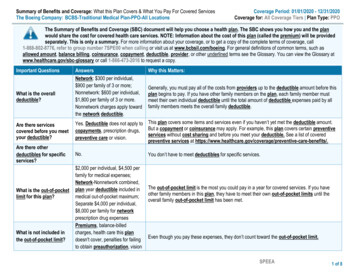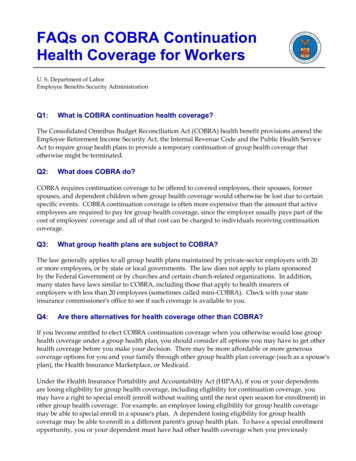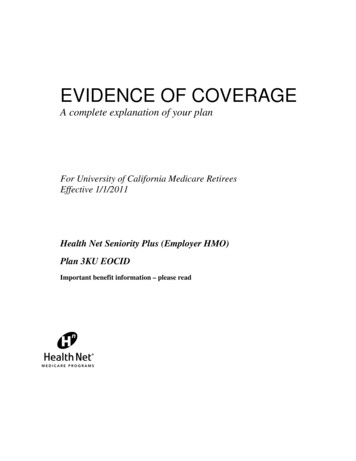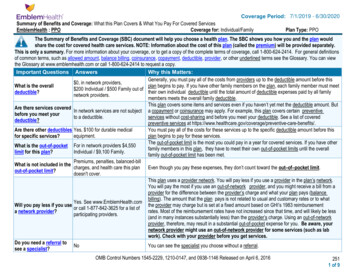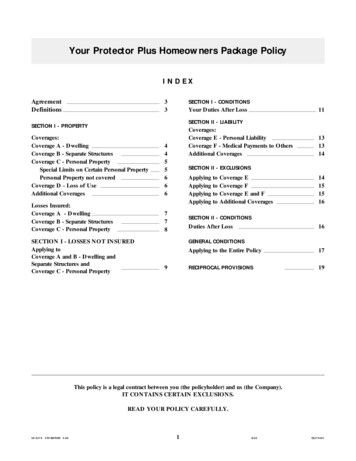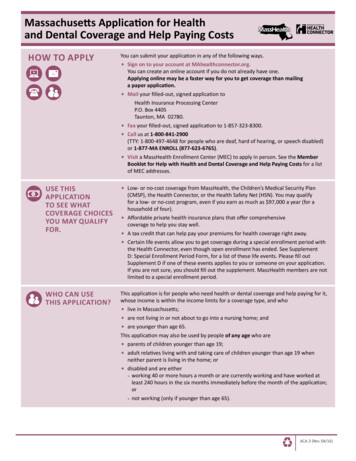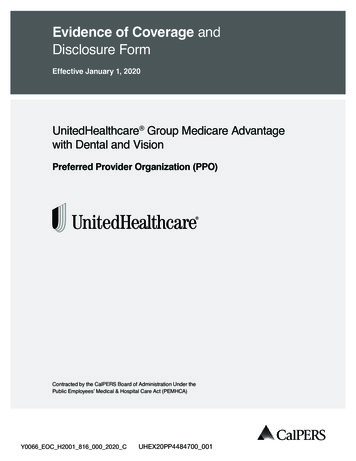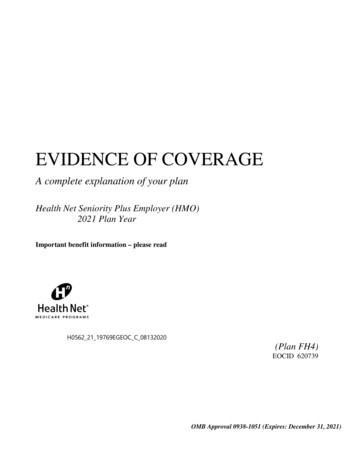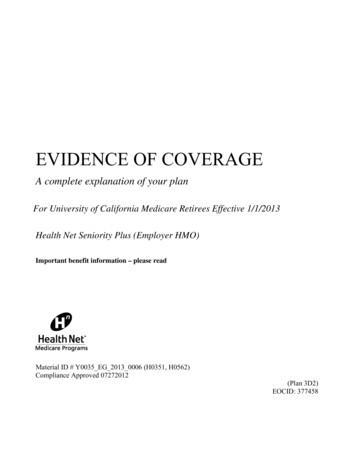
Transcription
EVIDENCE OF COVERAGEA complete explanation of your planFor University of California Medicare Retirees Effective 1/1/2013Health Net Seniority Plus (Employer HMO)Important benefit information – please readMaterial ID # Y0035 EG 2013 0006 (H0351, H0562)Compliance Approved 07272012(Plan 3D2)EOCID: 377458
Schedule changes in 2013This page is not an official statement of benefits. Your benefits are described in detail in theEvidence of Coverage. We have also edited and clarified language throughout the Evidence ofCoverage in addition to the items listed below.Changes to this Plan:¾ Urgent Care copayment - The Urgent Care copayment has beenchanged from 15 to 20.¾Emergency Services copayment - The Emergency Servicescopayment has been changed from 50 to 65.¾Office Visit copayment - The Office Visit copayment has beenchanged from 15 to 20.¾Outpatient Surgery in hospital and non-hospitalbased ambulatory surgical center copayment - TheOutpatient Surgery in hospital and non-hospital based ambulatory surgicalcenters copayment has been changed from 0 to 100.¾Routine Chiropractic Services copayment – The RoutineChiropractic Services copayment has been changed from 15 to 20.¾Outpatient Mental Health Care copayment - TheOutpatient Mental Health Care copayment has been changed from 15 to 20for individual therapy sessions and from 7.50 to 10 for group therapysessions.¾Outpatient Substance Abuse Services copayment The Outpatient Substance Abuse Services copayment has been changed from 15 to 20 for individual therapy sessions and from 7.50 to 10 for grouptherapy sessions.¾Smoking Cessation Drugs copayment – The SmokingCessation Drugs copayment has been changed from 20 to 0.¾Pharmacy Drug copayment - The copayment has been changedfrom 5/ 20/ 35 to 5/ 25/ 40.Note:Once you enroll in Medicare, your behavioral health provider network will bedifferent and you will need to obtain new authorizations/self referrals toEOC ID: 377458
2011 Evidence of Coverage for Health Net Seniority Plus (Employer HMO)Table of Contentsbehavioral health providers. Please review your Health Net ID card for theappropriate phone number for Mental Health and Substance Abuse.4
UNIVERSITY OF CALIFORNIA ELIGIBILITY, ENROLLMENT,TERMINATION AND PLAN ADMINISTRATION PROVISIONSJanuary 1, 2013The following information applies to the University of California plan and supersedes anycorresponding information that may be contained elsewhere in the document to which this insertis attached. The University establishes its own medical plan eligibility, enrollment andtermination criteria based on the University of California Group Insurance Regulations("Regulations") and any corresponding Administrative Supplements. Portions of theseRegulations are summarized below.ELIGIBILITYIndividuals eligible to enroll in this Plan are described below, except that if the Plan is a HealthMaintenance Organization (HMO) only those eligible individuals who they meet the Plan'sgeographic service area criteria may enroll. Anyone enrolled in a non-University MedicareAdvantage Managed Care contract or enrolled in a non-University Medicare Part D PrescriptionDrug Plan will be deenrolled from this Plan.SubscriberEmployee:You are eligible if you are appointed to work at least 50% time for twelve monthsor more or are appointed at 100% time for three months or more or haveaccumulated 1,000* hours while on pay status in a twelve-month period. Toremain eligible, you must maintain an average regular paid time** of at least 17.5hours per week and continue in an eligible appointment. If your appointment is atleast 50% time, your appointment form may refer to the time period as follows:"Ending date for funding purposes only; intent of appointment is indefinite (formore than one year)."* Lecturers - see your benefits office for eligibility.** Average Regular Paid Time - For any month, theaverage number of regular paid hours per week(excluding overtime, stipend or bonus time) workedin the preceding twelve (12) month period. Averageregular paid time does not include full or partialmonths of zero paid hours when an employee worksless than 43.75% of the regular paid hours availablein the month due to furlough, leave without pay orinitial employment.Retiree:EOC ID: 377458A former University Employee receiving monthly benefits from a defined benefitplan to which the University contributes.
You may be eligible for University medical plan coverage as a Retiree providedthat you meet the following requirements:(a) You meet the University's service credit requirements for Retiree medicaleligibility;(b) You elect to receive your retirement benefits in the form of monthlypayments;(c) The effective date of your retirement is within 120 calendar days of the dateyour University employment ends; and(d) You elect to continue (or suspend) medical coverage prior to the effective dateof your retirement.For more information, see the UC Group Insurance Eligibility Factsheet forRetirees and Eligible Family Members or the Survivor and BeneficiaryHandbook.If you are eligible for Medicare, you must follow UC’s Medicare Rules. See"Effect of Medicare on Retiree Enrollment" below.UCRP Disabled Member: If you are approved for Disability Income from the University ofCalifornia Retirement Plan (UCRP), you may be eligible to continue yourUniversity medical plan coverage after you separate from University employment,provided you were enrolled in medical coverage when you separated, yourcoverage is continuous until your Disability Income begins, and you meet anyother University coverage requirements.For more information, see the University of California Retirement Plan DisabilityHandbook.Survivor:If you are a surviving Family Member of a deceased Employee or Retiree, andyou are receiving monthly benefits from a defined benefit plan to which theUniversity contributes, you may be eligible to receive medical coverage as setforth in the University’s Group Insurance Regulations. (Note: Survivors receivingUniversity-sponsored medical coverage may NOT enroll a spouse or domesticpartner for coverage as a Family Member.)For more information, see the applicable Survivor and Beneficiary Handbook.Medicare Eligible: If you are eligible for Medicare, you must follow UC’s Medicare Rules. See"Effect of Medicare on Enrollment" below.Eligible Family MembersWhen you enroll any individual(s) in the Plan as a Family Member, you must providedocumentation specified by the University verifying that the individual(s) you have enrolledmeet(s) the eligibility requirements outlined below. The Plan may also require documentationverifying eligibility status. In addition, the University and/or the Plan reserve the right to
periodically request documentation to verify the continued eligibility of enrolled FamilyMembers.Eligible Adult: You may enroll one eligible adult Family Member, in addition to yourselfSpouse: Your legal spouse.Domestic Partner:You may enroll your same-sex domestic partner if your partnership is registeredwith the State of California or otherwise meets criteria as a domestic partnershipas set forth in the University of California Group Insurance Regulations. Samesex domestic partners from jurisdictions other than California will be covered tothe extent required by law. You may enroll your opposite-sex domestic partneronly if either you or your domestic partner is age 62 or older and eligible toreceive Social Security benefits based on age.Note: An adult dependent relative is not eligible for coverage in UC plans unlessenrolled prior to December 31, 2003 and continuously eligible and enrolledsince that date. To review the ongoing eligibility requirements for enrolled adultdependent relatives, see the Group Insurance Eligibility Factsheet for Employeesand Eligible Family Members or the Group Insurance Eligibility Factsheet forRetirees and Eligible Family Members.Also, remember: If your eligible adult dependent relative is still enrolled inthe Plan, you cannot also enroll your spouse or domestic partner.Child:All eligible children must be under the limiting age of 26 (18 for legal wardsexcept for a child who is incapable of self support due to a mental or physicaldisability. The following categories are eligible:(a)(b)(c)(d)your natural or legally adopted children;your spouse’s natural or legally adopted children (your stepchildren);your eligible domestic partner’s natural or legally adopted children;grandchildren of you, your spouse or your eligible domestic partner ifunmarried, living with you, dependent on you, your spouse or your eligibledomestic partner for at least 50% of their support and are your, your spouse's,or your eligible domestic partner’s dependents for income tax purposes;(e) children for whom you are the legal guardian if unmarried, living with you,dependent on you for at least 50% of their support and are your dependents forincome tax purposes.(f) children for whom you are legally required to provide group health insurancepursuant to an administrative or court order. (Child must also meet UCeligibility requirements.)
Any child described above (except a legal ward) who is incapable of self-supportdue to a physical or mental disability may continue to be covered past age 26provided:- the plan-certified disability began before age 26, the child was enrolled in aUC group medical plan before age 26 and coverage is continuous;- the child is chiefly dependent upon you, your spouse, or your eligibledomestic partner for support and maintenance; (50% or more) and- the child is claimed as your, your spouse’s, or your eligible domestic partner’sdependent for income tax purposes, or if not claimed as such dependent forincome tax purposes, is eligible for Social Security Income or SupplementalSecurity Income as a disabled person or working in supported employmentwhich may offset the Social Security or Supplemental Security Income.Except as provided below, application for coverage beyond age 26 due todisability must be made to the Plan 60 days prior to the date coverage is to enddue to reaching limiting age. If application is received timely but the Plan doesnot complete determination of the child’s continuing eligibility by the date thechild reaches the Plan’s upper age limit, the child will remain covered pending thePlan’s determination. The Plan may periodically request proof of continueddisability, but not more than once a year after the initial certification. Disabledchildren approved for continued coverage under a University-sponsored medicalplan are eligible for continued coverage under any other University-sponsoredmedical plan; if enrollment is transferred from one plan to another, a newapplication for continued coverage is not required; however, the new Plan mayrequire proof of continued disability, but not more than once a year.If you are a newly hired Employee with a disabled child over age 26 or if younewly acquire a disabled child over age 26 (through marriage, adoption, ordomestic partnership), you may also apply for coverage for that child. The child’sdisability must have begun prior to the child turning age 26. Additionally, thechild must have had continuous group medical coverage since age 26, and youmust apply for University coverage during your Period of Initial Eligibility. ThePlan will ask for proof of continued disability, but not more than once a year afterthe initial certification.
Important Note: The University complies with federal and state law in administering its groupinsurance programs. Health and welfare benefits and eligibility requirements, includingdependent eligibility requirements are subject to change (e.g., for compliance with applicablelaws and regulations). The University also complies with federal and state income tax lawswhich are subject to change. Requirements may include laws mandating that the employercontribution for coverage provided to certain Family Members be treated as imputed income tothe Employee or Retiree. See At Your Service online for related information. Contact your taxadvisor for additional information.No Dual CoverageEligible individuals may be covered under only one of the following categories: as an Employee,a Retiree, a Disabled Member, a Survivor or a Family Member. If an Employee and theEmployee’s spouse or domestic partner are both eligible for coverage, each may enroll separatelyor one may enroll and cover the other as a Family Member. If they enroll separately, neither mayenroll the other as a Family Member. Eligible children may be enrolled under either parent's oreligible domestic partner’s coverage but not under both. Additionally, a child who is also eligibleas an Employee may not have dual coverage through two University-sponsored medical plans.More InformationFor information on who qualifies and how to enroll, contact the person who handles benefits foryour location or the University of California's (UC) Customer Service Center at (800) 888-8267.You may also access eligibility factsheets on UC’s At Your Service web site:http://atyourservice.ucop.edu.ENROLLMENTFor information about enrolling yourself or an eligible Family Member, contact the person atwho handles benefits for your location. If you are a Retiree or a surviving Family Member,contact the UC Customer Service Center. Enrollment transactions may be completed by paperform or electronically, according to current University practice, during a Period of InitialEligibility (PIE), which may occur when you first become eligible or when you have anotherenrollment opportunity.During a Period of Initial Eligibility (PIE)A PIE begins the day you become eligible and ends 31 days after it began (but see exceptionunder “Special Circumstances” paragraph 1.d below). Also see “At Other Times for Employeesand Retirees” below. Electronic enrollment transactions must be completed online by the lastday of the applicable PIE. Paper enrollment forms must be received at the location specified onthe form by the last day of the applicable PIE, except that if the last day of the PIE falls on aweekend or holiday, the PIE is extended to the following business day.EmployeeIf you are an Employee, you may enroll yourself and any eligible Family Members during yourPIE. Your PIE starts the day you become an eligible Employee.
RetireeIf you are a Retiree who is eligible for Retiree medical coverage, keep in mind that retirementalone does not entitle you to a PIE to change your medical plan or to enroll yourself and/or youreligible Family Members in medical plan coverage.If you and any eligible Family Members were enrolled in a University-sponsored medical planimmediately before your retirement, and you are eligible for Retiree medical, you may continuecoverage in that plan (or, if applicable, its Medicare version upon completion of Medicareassignment) for yourself and your enrolled Family Members; you may change plans and/or addeligible Family Members during the University’s next open enrollment period or at certain othertimes, as described below (See “At Other Times for Employees and Retirees”).If you are eligible for Retiree medical coverage when you retire, but you are enrolled, or enroll,in non-University sponsored medical coverage at that time (e.g., medical coverage provided byyour spouse’s or domestic partner’s employer), you may elect to suspend your Retiree coverage.You must elect to continue or suspend enrollment before the effective date of your retirement.For more information, see the UC Group Insurance Eligibility Factsheet for Retirees andEligible Family Members.Similar rules apply to Survivors. For more information, see the Survivor and BeneficiaryHandbook.Family MembersA newly eligible Family Member's PIE starts the day he or she becomes eligible, as describedbelow. During this PIE, you may enroll the newly eligible Family Member as well as yourselfand/or any other eligible Family Member(s) if not already enrolled. If you are already enrolled inthis Plan, you may add your current and newly eligible Family Member(s) to the Plan or youmay enroll yourself and all eligible Family Members in a different University-sponsored plan.However, you must enroll yourself in order to enroll any eligible Family Members, and you andall eligible Family Members must be enrolled in the same plan.Note: If you are a Survivor receiving University-sponsored medical coverage, you may NOTenroll a spouse or domestic partner for coverage as a Family Member.Family Member Eligibility Dates(a) For a spouse, on the date of marriage.(b) For a Domestic Partner, on the date the domestic partnership is legally established. Alsosee “At Other Times for Employees and Retirees” below.(c) For a natural child, on the child's date of birth.(d) For an adopted child, the earlier of:
(i) the date the child is placed for adoption with the Employee/Retiree, or(ii) the date the Employee/Retiree or Spouse/Domestic Partner has the legal right tocontrol the child’s health care.A child is “placed for adoption” with the Employee/Retiree as of the date theEmployee/Retiree assumes and retains a legal obligation for the child’s total or partialsupport in anticipation of the child’s adoption.If the child is not enrolled during the PIE beginning on that date, there is an additionalPIE beginning on the date the adoption becomes final.(e) For a legal ward, the effective date of the legal guardianship(f) Where there is more than one eligibility requirement, the date all requirements aresatisfied.If you are in a Health Maintenance Organization and you move or are transferred out of thatPlan’s service area, or will be away from the Plan’s service area for more than the time periodspecified under the terms of the Plan, you will have a PIE to enroll yourself and your eligibleFamily Members in another University medical plan available in the new location. Your PIEstarts with the effective date of the move or the date you leave the Plan’s service area. If youreturn to your original location, and the plan providing coverage prior to your return is notavailable in that location, you will again have a PIE to enroll in any University medical plan.Otherwise, you may change plans during the University’s next open enrollment period or atcertain other times, as described below under “At Other Times for Employees and Retirees.”At Other Times for Employees and RetireesOpen Enrollment Period. You and your eligible Family Members may also enroll during agroup open enrollment period established by the University.90-Day Waiting Period. If you are an Employee and miss an opportunity to enroll yourselfduring a PIE or open enrollment period, you may enroll yourself at any other time uponcompletion of a 90 consecutive calendar day waiting period unless one of the “SpecialCircumstances” described below applies.If you are an Employee or Retiree and fail to enroll your eligible Family Members during a PIEor open enrollment period, you may enroll your eligible Family Members at any other time uponcompletion of a 90 consecutive calendar day waiting period unless one of the “SpecialCircumstances” described below applies.The 90-day waiting period starts on the date the completed enrollment form is received at thelocation specified on the form and ends 90 consecutive calendar days later.Newly Eligible Child. If you have one or more children enrolled in the Plan, you may add anewly eligible Child at any time. See "Effective Date."
Special Circumstances. You may enroll before the end of the 90-day waiting period or withoutwaiting for the University’s next open enrollment period if you are otherwise eligible under anyone of the circumstances set forth below:1. You have met all of the following requirements:a. You were covered under another health plan as an individual or dependent, includingcoverage under COBRA or Cal-COBRA (or similar program in another state), theChildren’s Health Insurance Program or “CHIP” (called the Healthy Families Program inCalifornia), or Medicaid (called Medi-Cal in California).b. You stated at the time you became eligible for coverage under a University-sponsoredPlan that you were opting out or if applicable, suspending, coverage under this Planbecause you were covered under another health plan as stated above.c. Coverage under another health plan for you and/or your eligible Family Members endedbecause you/they lost eligibility under the other plan or employer contributions towardcoverage under the other plan terminated, your coverage under COBRA or Cal-COBRAcontinuation was exhausted, or coverage under CHIP or Medicaid was lost becauseyou/they were no longer eligible for those programs.d. You properly file an application with the University during the PIE which starts on theday after the other coverage ends. Note that if you lose coverage under CHIP orMedicaid, your PIE is 60 days.2. You or your eligible Family Members are not currently enrolled and in the UC-sponsoredmedical coverage you or your eligible Family Members become eligible for premiumassistance under the Medi-Cal Health Insurance Premium Payment (HIPP) Program or aMedicaid or CHIP premium assistance program in another state. Your PIE is 60 days fromthe date you are determined eligible for premium assistance. If the last day of the PIE falls ona weekend or holiday, the PIE is extended to the following business day if you are enrollingwith paper forms.3. A court has ordered coverage be provided for a dependent child under your UC-sponsoredmedical plan pursuant to applicable law and an application is filed within the PIE whichbegins the date the court order is issued. The child must also meet UC eligibilityrequirements.4. You have a change in family status through marriage or domestic partnership, or the birth,adoption, or placement for adoption of a child:a. If you are enrolling following marriage or establishment of a domestic partnership, youand your new spouse or domestic partner must enroll during the PIE. Your new spouse ordomestic partner’s eligible children may also enroll at that time. Coverage will beeffective as of the date of marriage or domestic partnership provided you enroll duringthe PIE.b. If you are enrolling following the birth, adoption, or placement for adoption of a child,your spouse or domestic partner, who is eligible but not enrolled, may also enroll at that
time. Application must be made during the PIE; coverage will be effective as of the dateof birth, adoption, or placement for adoption provided you enroll during the PIE.5. For Employees, you and/or an eligible Family Member experiences an event not otherwisecovered by paragraphs 1 through 4, above, that would permit enrollment under the terms ofthe University of California Tax-Savings on Insurance Premiums Plan and Section 125 of theInternal Revenue Code. For more information on permitted change events, see the TaxSavings on Insurance Premiums (TIP) Summary Plan Description.Effective DateThe following effective dates apply provided the appropriate enrollment transaction (paper formor electronic) has been completed within the applicable enrollment period.If you enroll during a PIE, coverage for you and your Family Members is effective the date thePIE starts.If you are a Retiree continuing enrollment in conjunction with retirement, coverage for you andyour Family Members is effective on the first of the month following the first full calendarmonth of retirement income.The effective date of coverage for enrollment during an open enrollment period is the dateannounced by the University.For enrollees who complete a 90-day waiting period, coverage is effective on the 91stconsecutive calendar day after the date the completed enrollment form is received, unless theenrollee is Medicare-eligible. Coverage for Medicare-eligible enrollees will be effective as of thefirst of the month following the end of the 90-day waiting period.An Employee or Retiree already enrolled in adult plus child (ren) or family coverage may addadditional children, if eligible, at any time after their PIE. Retroactive coverage is limited to thelater of:(a) the date the Child becomes eligible, or(b) a maximum of 60 days prior to the date your Child’s enrollment form is received bythe person who handles benefits for your location (or the UC Customer ServiceCenter if you are a Retiree or Survivor).Change in CoverageIn order to make any of the changes described above, contact the person who handles benefits foryour location (or the UC Customer Service Center if you are a Retiree or Survivor).Effect of Medicare on EnrollmentExcept as provided below, if you are a Retiree or Survivor and you and/or an enrolled FamilyMember is or becomes eligible for premium-free Medicare Part A (Hospital Insurance) asprimary coverage, then you and/or your Family Member must also enroll in and remain inMedicare Part B (Medical Insurance). This includes individuals eligible for Medicare benefits
through their own or their spouse's employment. If an individual (Retiree or FamilyMember) fails to enroll at the earliest opportunity, he or she will still be required to do soeven if a Medicare late enrollment penalty applies.Individuals enrolled in both Part A and Part B are then eligible for the Medicare premiumapplicable to this plan.Retirees or Survivors or their Family Member(s) who become eligible for premium-freeMedicare Part A on or afterJanuary 1, 2004 and do not enroll in and continue Part B will permanently lose their UCsponsored medical coverage.Retirees or Survivors and their Family Members who were eligible for premium-free MedicarePart A between July 1, 1991 and January 1, 2004, but declined to enroll in Part B of Medicare,are assessed a monthly offset fee by the University to cover increased costs. The offset fee mayincrease annually, but will stop when the Retiree or Family Member becomes covered under PartB.Retirees or Survivors or Family Members who are not eligible for premium-free Part A will notbe required to enroll in Part B, they will not be assessed an offset fee, nor will they lose theirUC-sponsored medical coverage if they remain ineligible to enroll based on their own or theirspouse’s employment. Documentation attesting to their ineligibility for Medicare Part A will berequired.An exception to the above rules applies to Retirees or Survivors or Family Members in thefollowing categories who will be eligible for the non-Medicare premium applicable to this planand will also be eligible for the benefits of this plan without regard to Medicare:a) Individuals who were eligible for premium-free Part A, but not enrolled in Medicare PartB prior to July 1, 1991.b) Individuals who are not eligible for premium-free Part A.Upon Medicare eligibility, you or your Family Member must complete a University of CaliforniaMedicare Declaration form, as well as submit a copy of your Medicare card. This notifies theUniversity that you are covered by Part A and Part B of Medicare. The University's MedicareDeclaration form is available through the UC Customer Service Center or from the web site:http://atyourservice.ucop.edu. Completed forms should be returned to University of California,Human Resources, Retiree Insurance Program, Post Office Box 24570, Oakland, CA 946231570.Any individual enrolled in a University-sponsored Medicare Advantage Managed Care contractmust assign his/her Medicare benefit (including Part D) to that plan or lose UC-sponsored medicalcoverage. Anyone enrolled concurrently in a non-University Medicare Advantage Managed Carecontract will be deenrolled from this health plan. Any individual enrolled in a Universitysponsored Medicare Part D Prescription Drug Plan must assign his/her Part D benefit to the plan or
lose UC-sponsored medical coverage. Anyone enrolled concurrently in a non-University MedicarePart D Prescription Drug Plan will be deenrolled from this health plan.Medicare Secondary Payer Law (MSP)The Medicare Secondary Payer (MSP) Law affects the order in which claims are paid byMedicare and a large employer group health plan. Employees or their opposite-sex spouses, age65 or over, and UC Retirees re-hired into positions making them eligible for UC-sponsoredmedical coverage, including CORE and mid-level benefits, are subject to the MSP rules. Underthose rules, Medicare becomes the secondary payer and the employer plan becomes the primarypayer. The MSP rules do not apply to an Employee’s or Retiree’s same-sex spouse or domesticpartner, age 65 or over, who is covered as a Family Member under a University-sponsored plan.Medicare is primary for those individuals.Medicare Private Contracting Provision and Providers Who do Not Accept MedicareFederal Legislation allows physicians or practitioners to opt out of Medicare. Medicarebeneficiaries wishing to continue to obtain services (that would otherwise be covered byMedicare) from these physicians or practitioners will need to enter into written "privatecontracts" with these physicians or practitioners. These private agreements will require thebeneficiary to be responsible for all payments to such medical providers. Since services providedunder such "private contracts" are not covered by Medicare or this Plan, the Medicare limitingcharge will not apply.Some physicians or practitioners have never participated in Medicare. Their services (that wouldbe covered by Medicare if they participated) will not be covered by Medicare or this Plan, andthe Medicare limiting charge will not apply.If you are classified as a Retiree by the University (or otherwise have Medicare as a primarycoverage), are enrolled in Medicare Part B, and choose to enter into such a "private contract"arrangement as described above with one or more physicians or practitioners, or if you choose toobtain services from a provider who does not participate in Medicare, under the law you have ineffect "opted out" of Medicare for the services provided by these physicians or otherpractitioners. In either case, no benefits will be paid
2011 Evidence of Coverage for Health Net Seniority Plus (Employer HMO) Table of Contents 4 behavioral health providers. Please review your Health Net ID card for the appropriate phone numbe
